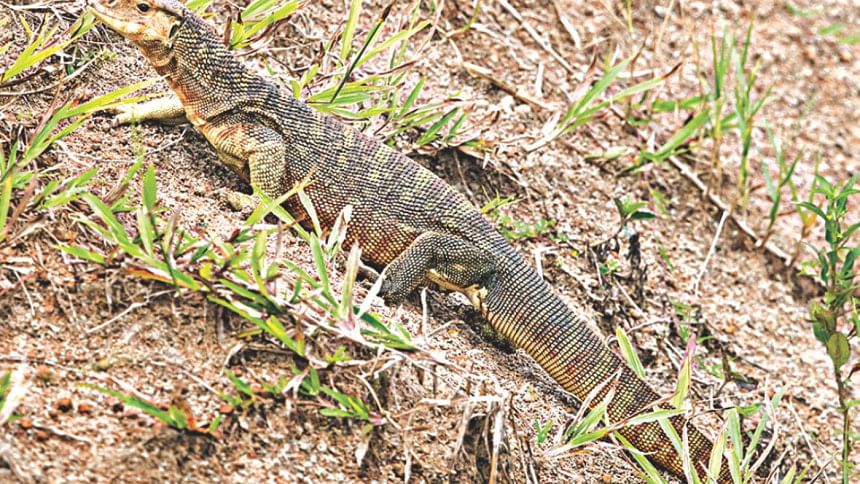Our Monitors

Everyone knows about Indonesia's Komodo dragons but did you know we have three closely related species of lizards here in Bangladesh?
I have seen all three, the last one only a month ago. At first, looking down from a small bridge in Purbachol, I thought it was a snake swimming through the lake's water. Its head stuck out and V-shaped ripples followed on its wake, defining its progress. As it came closer the head appeared larger than a snake's. Presently it turned towards the shore of the small lake. Its head protruded and its tongue darted out, sniffing the air. Only then did I realize it was the large lizard known as a monitor (guishap.) But its colour was different from other two monitors I have seen, which are black. This one was golden yellow with a beautiful pattern.
I decided to ask an expert, Dr. Md. Kamrul Hasan, a professor at Jahangirnagar University and author (with Dr. Md. Monirul Khan and Dr. Md. Mostafa Zeeroz) of the book Amphibians and Reptiles of Bangladesh: A Field Guide. Kamrul pointed out that there are three species of monitors in Bangladesh: Bengal monitor, golden monitor and ring lizard (or water monitor.) They are non-venomous and harmless unless cornered. The first two live close to human habitats, while ring lizards are seen inside the forest. Ring lizards are the largest at 150 cm. Bengal monitors are about a metre long while golden monitors are somewhat smaller. In comparison, the Komodo dragon, is around three metres, and, I believe, quite dangerous.
Bengal monitors are seen all over Bangladesh. In Dhaka, I have seen them many times in the National Botanical Garden (often near the cactus house) as well as in the fields of Purbachol. They usually escape quickly when they see me, but once I came close without detection. When it finally saw me, it broke into a swift but awkward run, its bulbous body swaying side to side much like a fat penguin waddling quickly.
I asked Kamrul about the population of monitors in Bangladesh. Bengal and golden monitors have good presence here, but they are considered “Near-Threatened” by IUCN because of human pressure. Kamrul explained why. Their eggs take 7-10 months to hatch. All this time, eggs must be in nest, which the monitor builds on upward-sloping ground, such as ails and borders of farm plots. In our intensive farming nation, it is hard for even the smallest patch of land to remain untouched for long, so their nests are constantly disturbed.
The ring lizards of Sundarban are considered “Vulnerable” by IUCN because of shrinking habitat due to human encroachment.
The ring lizard once gave me a thrill. Early one morning in 2012 in Sundarban, our tour group boarded a small boat to navigate a narrow creek in search of birds. Trees large and small grew on both sides and we passed under many overhanging branches. We had just crossed under one such branch when a ring lizard dived from that branch into the water with a loud splash, missing our boat by inches. If it had dived a second earlier it would have wreaked havoc on our boat.
Our monitors belong to the same genus (Varanus) as their Komodo cousins. They are part of the rich biodiversity of this land, and I hope they can survive and thrive here.
www.facebook.com/ikabirphotographs or follow ihtishamkabir on Instagram

 For all latest news, follow The Daily Star's Google News channel.
For all latest news, follow The Daily Star's Google News channel. 



Comments